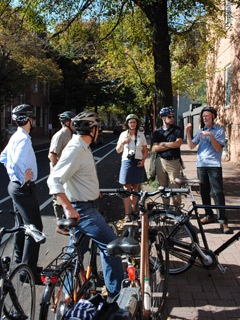 story by Julie Lorch“Race that train!” yelled Alex Doty. A familiar site was before us: a CSX train slowly lurching towards the Locust Street crossing to Schuylkill Banks Park. Charles Carmalt, Pedestrian and Bicycle Coordinator for the Mayor’s Office of Transportation and Utilities (MOTU), was already halfway across the tracks. About a dozen transportation officials from across the country quickly heeded Doty’s call, grabbed their bikes and raced across the tracks, narrowly escaping the certain doom of a blocked entrance.
story by Julie Lorch“Race that train!” yelled Alex Doty. A familiar site was before us: a CSX train slowly lurching towards the Locust Street crossing to Schuylkill Banks Park. Charles Carmalt, Pedestrian and Bicycle Coordinator for the Mayor’s Office of Transportation and Utilities (MOTU), was already halfway across the tracks. About a dozen transportation officials from across the country quickly heeded Doty’s call, grabbed their bikes and raced across the tracks, narrowly escaping the certain doom of a blocked entrance.
With everyone safely through—and still chuckling at the mayhem—the group discussed solutions to the bike versus train races that happen here daily. Doty, director of the Bicycle Coalition of Greater Philadelphia, beamed as he explained plans for the recently-funded Connector Bridge, an infrastructure project that will eliminate this unique bicycling hazard.
Wait, what? A dozen transportation officials from across the country are talking about improving cycling in Philadelphia? And they’re doing it while actually riding bikes?
What can I say—it was the most fantastic afternoon of bike geekery I’ve experienced in months. The four-hour ride was part of a two-day visit to Philadelphia organized by Cities for Cycling, a program led by the National Association of City Transportation Officials (NATCO). The mission of Cities is to create a dialogue between urban transportation officials, share best practices and advocate for the rapid implementation of innovative design. This time they came to Philadelphia—ranked highest in bicycle commuters per capita among the 10 largest U.S. cities (1.6 percent; nearly three times the national average of 0.55 percent)—to check out the goods.
The delegation included some heavy hitters: Jon Orcutt, Director of Policy for the New York City Department of Transportation, Robert Burchfield, City Traffic Engineer for the City of Portland DOT, Timothy Papandreou, Deputy Director of Transportation Planning and Development, San Francisco Metropolitan Planning Agency, and Eric Gilliland, Executive Director of NATCO.
Now, many of us love biking in Philadelphia—the city is easy to navigate and mostly flat, and there are a few key lanes and loads of people out there riding along with you—but other cities are way ahead of us in terms of infrastructure. Between 2006 and 2009, New York installed 200 miles of new on-street bike lanes. Portland has buffered and colored lanes, bicycle boulevards, cycle tracks and bike boxes. San Francisco has “floating bike lanes” that shift when parking is permitted on striped streets. It’s hard not to be jealous of those innovations.
On the evening following our ride, Cities representatives spoke at a MOTU forum at the Academy of Natural Sciences titled “Cities for Cycling: Riding the Innovation Line.” (I wasn’t kidding about the geekery). Turns out urban cyclists can be divided into four groups: the tiny selection of “Strong and Fearless,” the small group of “Enthused and Confident,” the large segment of “Interested but Concerned,” and the rest who say “No way, No How.” Most policy is directed at the “Interested but Concerned,” aiming to make urban cycling more attractive to that impressionable population.
Long story short, it’s all about the Benjamins, er, the infrastructure. Sure, Philly showed off the newly paved lanes along Pine and Spruce, the freshly striped lanes on South and Lombard around the South Street Bridge and the lovely but crowded Schuylkill Banks Park, but we still need ideas for how to reclaim the Delaware Waterfront, improve bike access to the Ben Franklin Bridge and redesign the Spring Garden bike lanes.
And that’s only the beginning.
Can you imagine Sansom Street as a Bike Preferred Corridor? Or cycle tracks on Broad and Girard? What about buffered lanes in the 5th Street tunnel, or along the Chestnut and Walnut Street Bridges? I know I suffer from if-you-give-a-mouse-a-cookie syndrome, but what if Spruce and Pine had “floating lanes” or bike boxes?
The next day, the delegation met with Mayor Nutter to discuss the overall state of bicycle infrastructure in Philadelphia, followed by meetings with city council to discuss legislative hurdles and past successes in other cities. You can bet no one brought up bicycle license plates.
Julie Lorch is a student and bike enthusiast;
she’s currently hard at work on where to bike: philadelphia, an upcoming print guide to cycling in the city.



